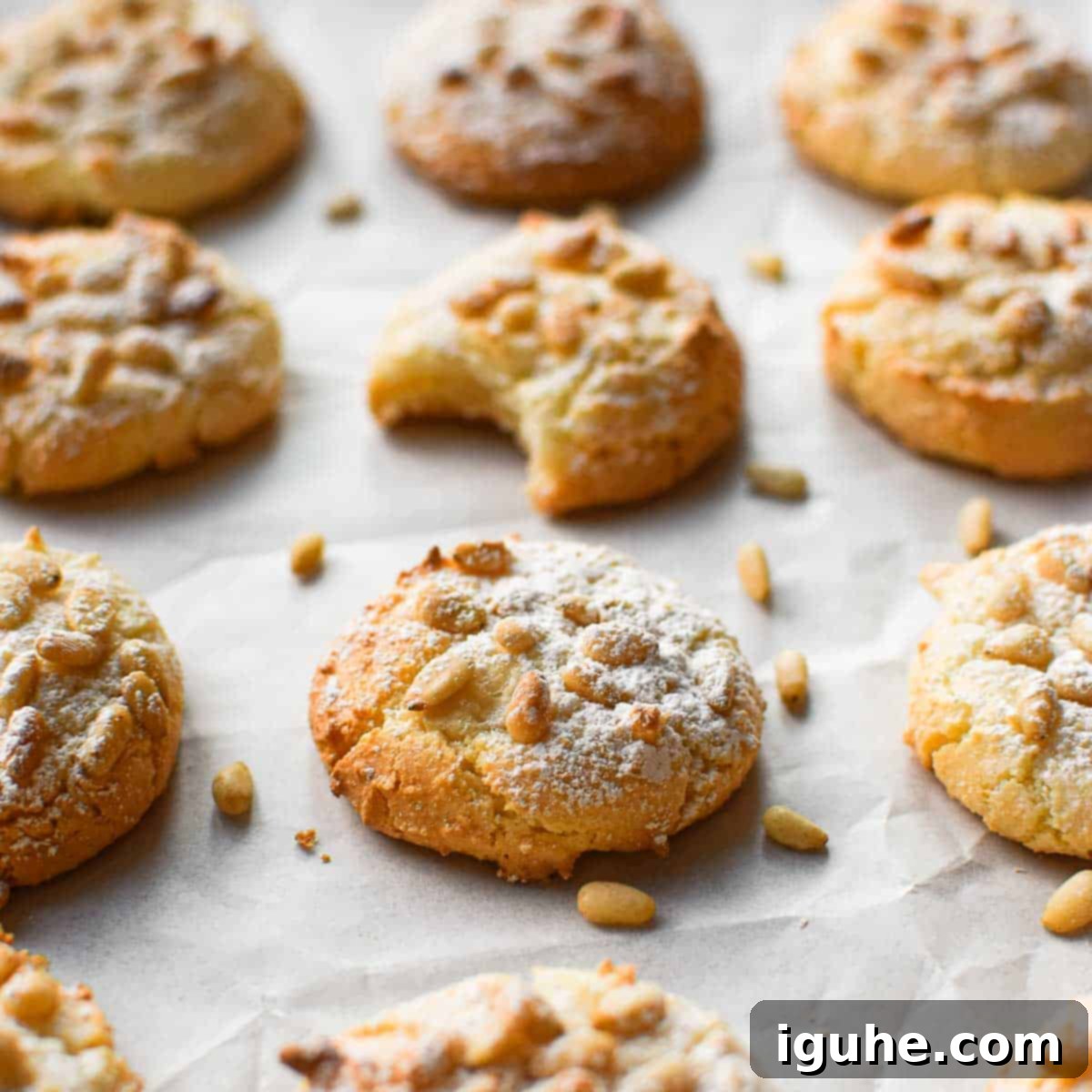Easy Homemade Italian Pignoli Cookies: Your Ultimate Guide to Perfect Pine Nut Delights (Naturally Gluten-Free!)
Italian pignoli cookies, also lovingly known as pine nut cookies, are a cherished tradition and a staple in both Italian and Italian-American bakeries. These exquisite treats are celebrated for their distinctive flavor and delightful texture, making them a must-have for any festive spread. Far superior to any store-bought version, our homemade pignoli cookies boast a wonderfully light and airy texture, a sweet almond essence, and a satisfyingly crunchy exterior of golden pine nuts. Best of all? They are made from just five simple ingredients and are naturally gluten-free, making them accessible for many to enjoy!
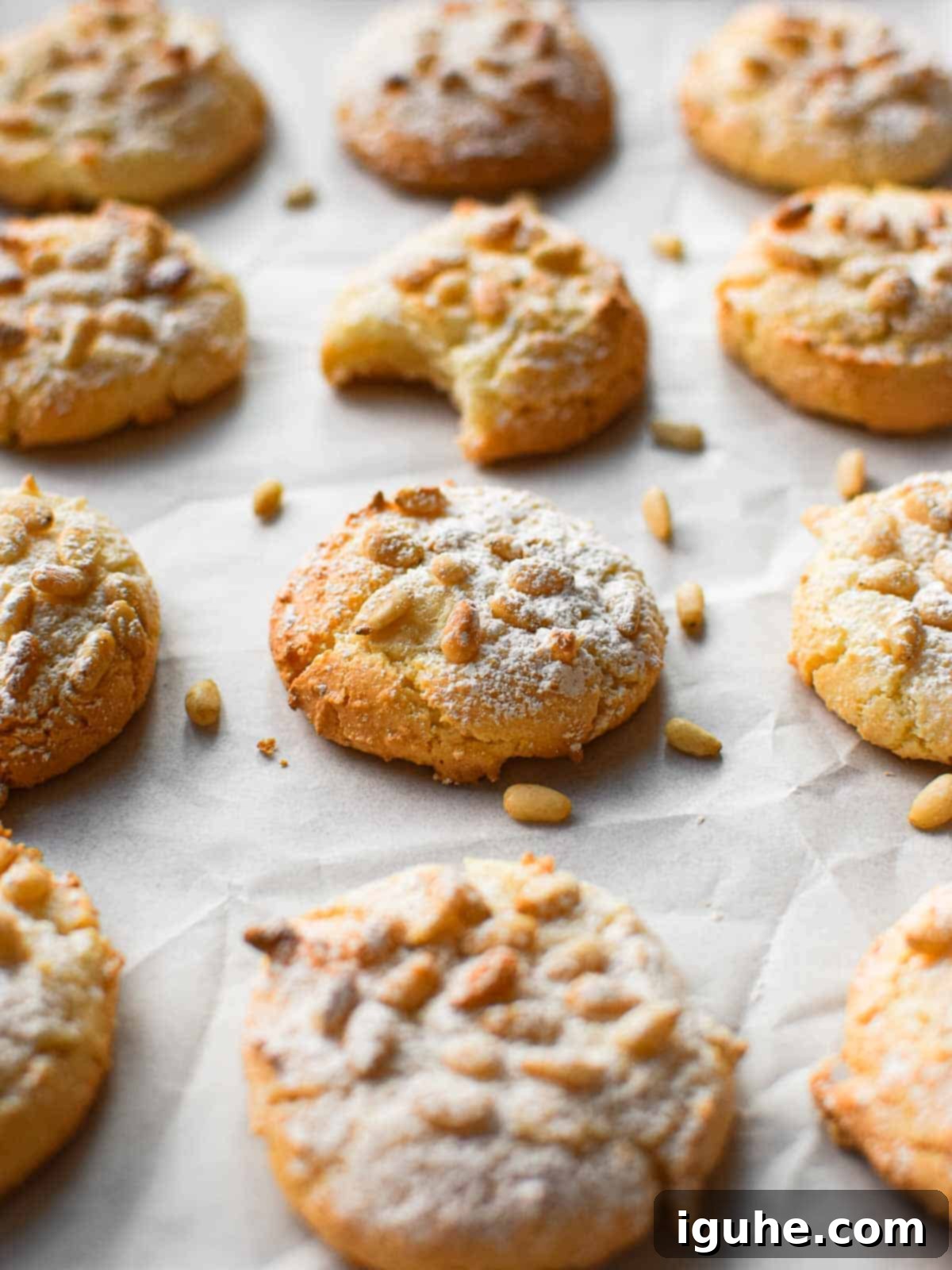
For my family, these easy Italian pignoli cookies are an indispensable part of our Christmas and Easter celebrations each year. They are always a massive hit, and frankly, no holiday dessert table feels complete without them, alongside other beloved classics like my Italian pizzelles and Italian lemon drop cookies. What makes pignoli cookies so special is their delicate balance: a subtly sweet almond taste, a signature crackly top, and a light yet delightfully chewy interior. Once baked to perfection, a dusting of powdered sugar adds an elegant finish and an extra touch of sweetness that makes them truly irresistible.
The Allure of Pignoli Cookies: A Timeless Italian Tradition
Pignoli cookies hold a special place in Italian culinary culture, particularly during holidays and celebrations. Originating from Southern Italy, these delicate almond-based cookies adorned with pine nuts have been passed down through generations. Their distinct appearance, with the golden pine nuts contrasting against the pale almond dough, makes them instantly recognizable and highly sought after. They embody the simplicity and richness of Italian baking, proving that a few high-quality ingredients can create something truly extraordinary. Whether enjoyed with a strong espresso, a glass of dessert wine, or as part of a lavish holiday platter, pignoli cookies offer a taste of Italian heritage that is both sophisticated and comforting.
Why Homemade Pignoli Cookies Outshine the Rest
While you might find pignoli cookies in some specialty bakeries, making them at home offers an unparalleled experience. The difference in freshness, flavor, and texture is immediately noticeable. Store-bought versions often lack the vibrant almond flavor and the perfectly chewy-yet-light consistency that comes from freshly prepared batter. When you bake them yourself, you control the quality of each ingredient, ensuring pure almond paste and fresh pine nuts contribute to the ultimate taste. Plus, the aroma of these cookies baking in your kitchen is an experience in itself, filling your home with the warm, inviting scent of almonds and toasted pine nuts – a sensory delight that prefaces the joy of eating them.
Essential Ingredients for Authentic Italian Pignoli Cookies
Crafting the perfect batch of Italian pine nut cookies begins with selecting the right ingredients. Here’s a detailed look at what you’ll need and why each component is crucial:
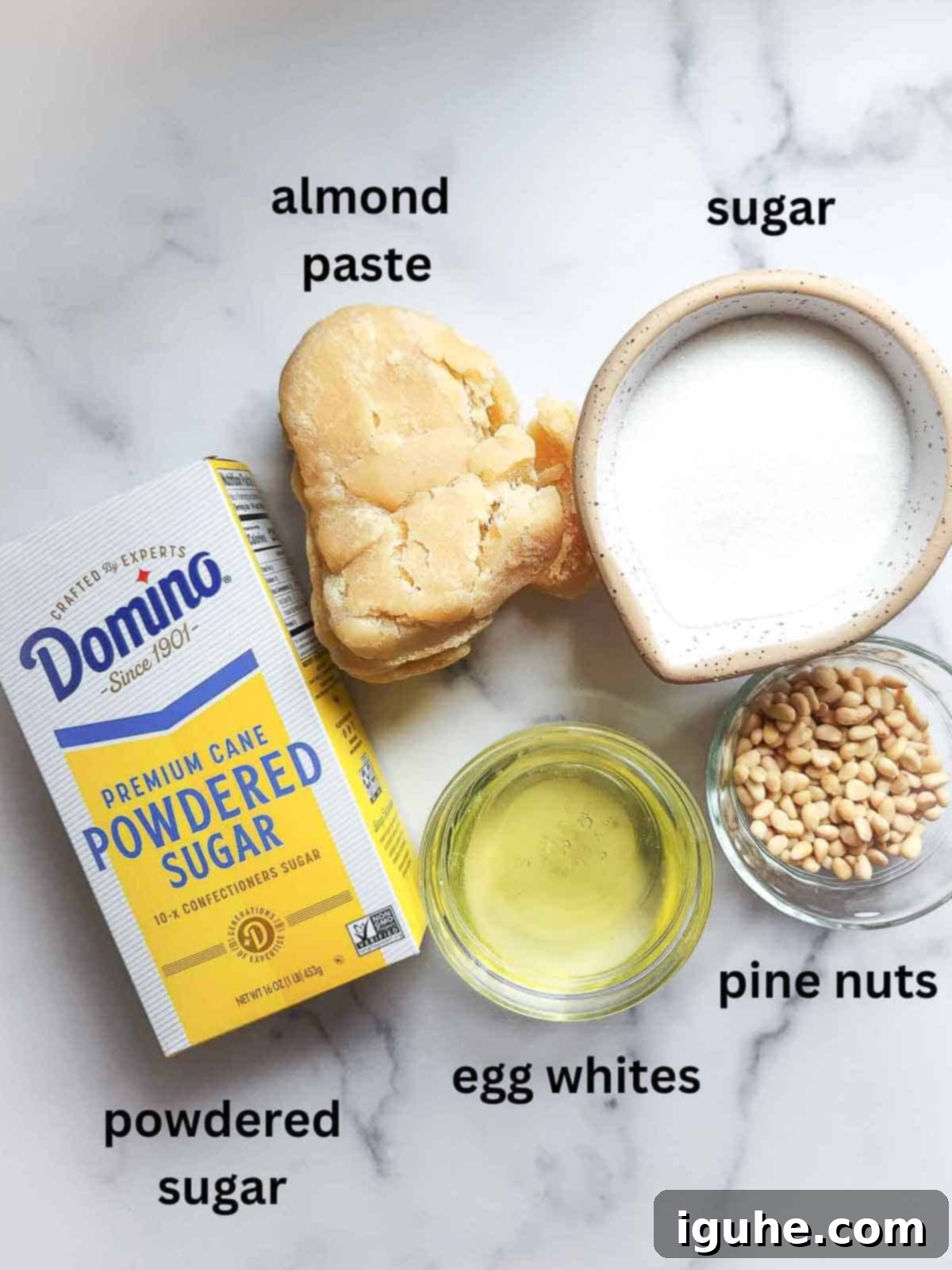
- Almond paste: This is the star ingredient and absolutely essential for authentic pignoli cookies. Be sure to use the “real deal” — true almond paste, not marzipan. Almond paste is coarser in texture, less sweet, and designed to hold up beautifully during baking, providing that rich, distinctive almond flavor and chewy interior. You can typically find it in the baking aisle of well-stocked grocery stores, often near specialty flours or nuts. If you have a local Italian bakery you adore, it’s worth asking if they sell almond paste directly; their quality is often superb. For store-bought options, I highly recommend the Solo brand, which usually comes in convenient 8-ounce boxes. For this recipe, you’ll need two boxes, totaling 16 ounces (or 1 pound).
- Sugar: Granulated white sugar is my go-to choice, providing the perfect level of sweetness and contributing to the cookies’ delicate crackly top. If you prefer, castor sugar (also known as superfine sugar) can be substituted for an even finer texture, though it’s not strictly necessary.
- Extra large egg whites: The secret to these cookies’ light and airy structure lies in using extra-large egg whites. It’s paramount that they are completely free of any trace of yolk, as even a tiny speck can prevent them from whipping correctly and affect the final texture. The size is also important; large egg whites can lead to a slightly different consistency, sometimes making the cookies flat or overly dense.
- Pine nuts: Known as “pignoli” in Italian, these edible seeds of various pine species are what give these cookies their name and characteristic flavor. Pine nuts can be quite expensive, especially when purchased in smaller quantities from specialty and local grocery stores. To save on cost, consider buying them in bulk online or from larger warehouse clubs like Costco, though even then, they can still be a significant investment. Their buttery, slightly sweet, and earthy flavor is irreplaceable for true pignoli cookies. If pine nuts are outside your budget, a good alternative is thinly sliced almonds, which will still provide a nice crunch and complement the almond paste flavor, though the overall taste and appearance will differ.
- Powdered sugar: This is used for a light dusting after the cookies have cooled. It enhances their visual appeal and adds a subtle, delicate sweetness, elevating them from delicious to truly gourmet.
Step-by-Step Guide to Baking Perfect Pignoli Cookies
Achieving the perfect Italian pine nut cookies is simpler than you might think with these easy-to-follow steps. Here’s a quick visual and detailed breakdown to help you get it right every time!
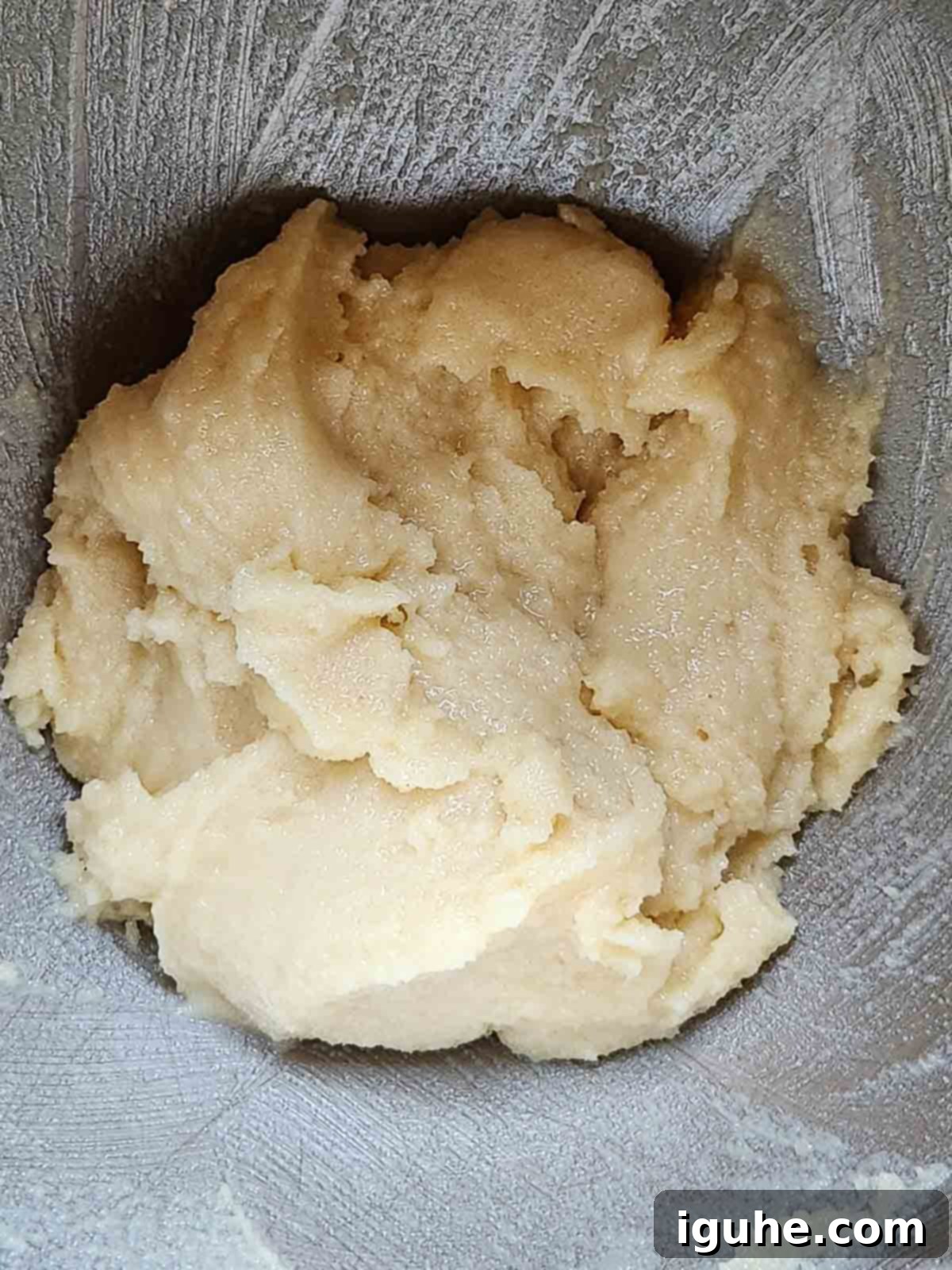
1. Prepare the Batter: Begin by placing the almond paste into the bowl of a stand mixer fitted with the paddle attachment. Beat on low speed for a few minutes, allowing the paste to smooth out and become more pliable. This initial step prevents clumping and ensures a uniform batter. Next, add the extra-large egg whites and granulated sugar. Increase the mixer speed to medium and beat for approximately 5 minutes, or until the mixture is beautifully smooth, creamy, and lightened in color. Be careful not to overbeat, as this can make the cookies dry.
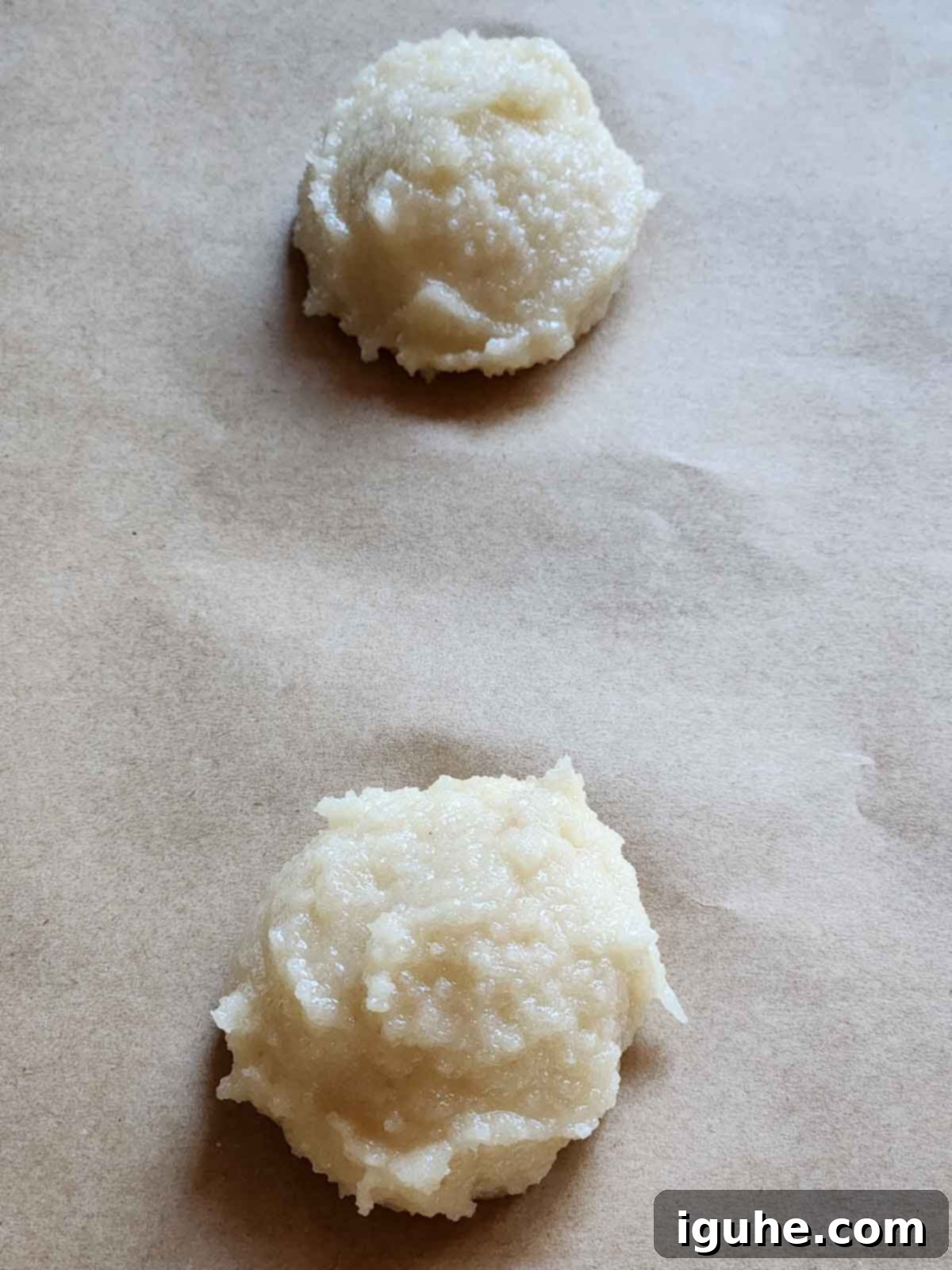
2. Rest and Scoop: Once the batter is smooth, allow it to rest for 5-10 minutes. This short rest allows the almond paste to fully hydrate and the batter to thicken slightly, making it much easier to handle and scoop. Using a cookie scoop (or heaping tablespoons for approximate sizing), drop uniform portions of the batter onto a parchment-lined baking sheet. Ensure the cookies are spaced about 1 inch apart to allow for proper air circulation and expansion during baking.
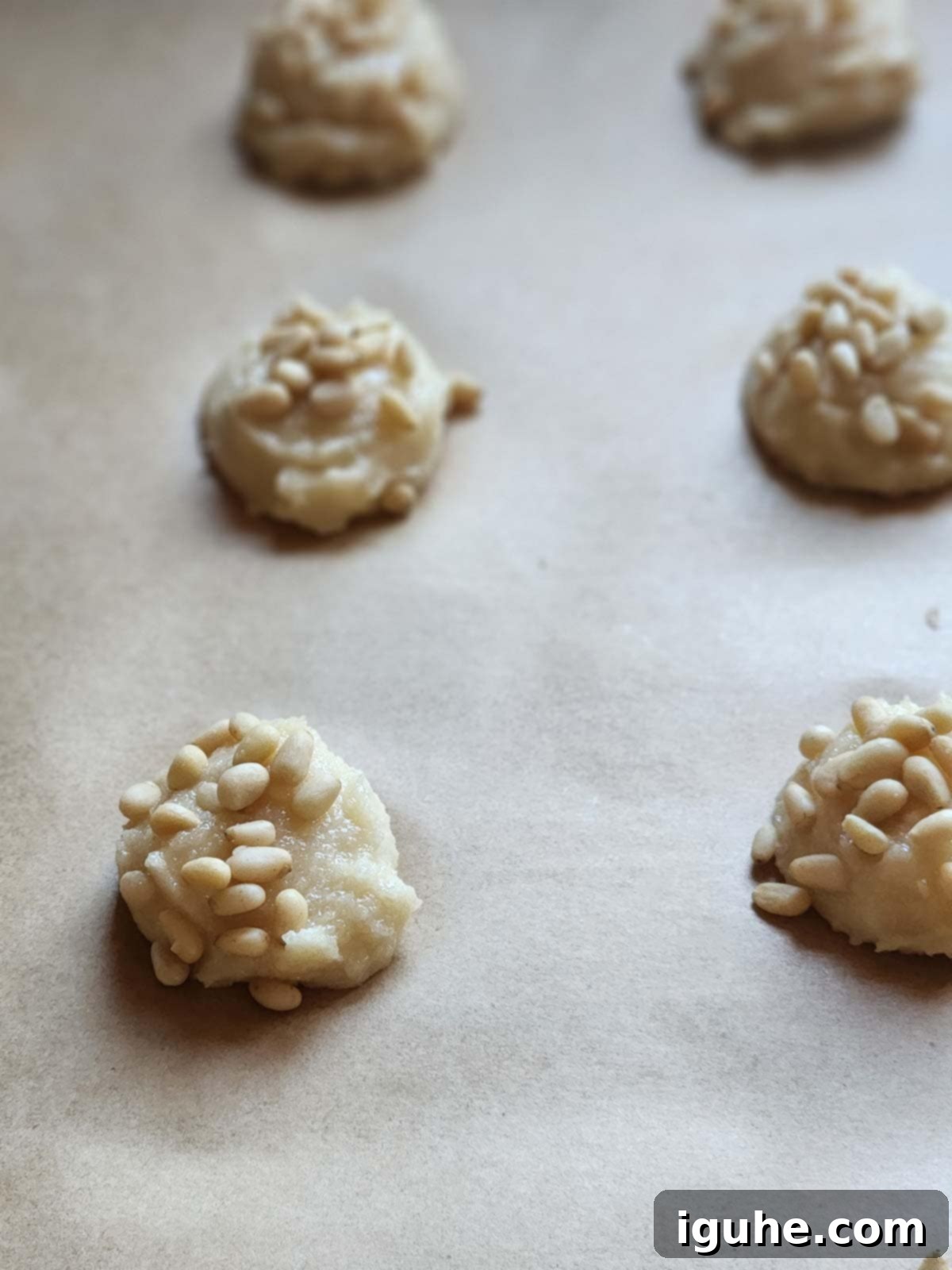
3. Add Pine Nuts: Generously, yet lightly, press about 15-20 pine nuts onto the top of each scooped cookie. The gentle pressure helps them adhere to the dough and ensures they stay in place during baking. This step is crucial for achieving that iconic pignoli cookie look and adding the wonderful nutty crunch.
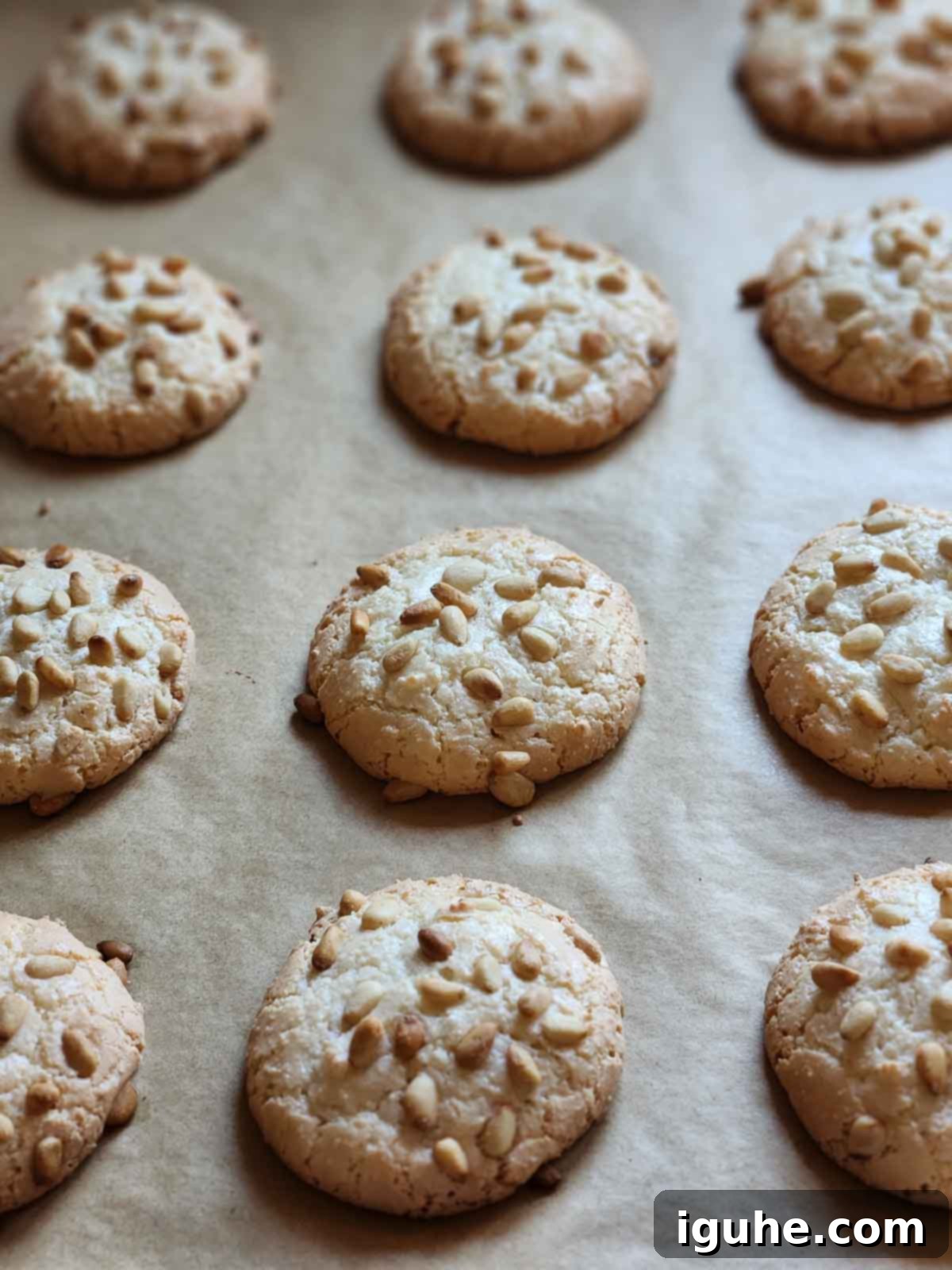
4. Bake to Perfection: Preheat your oven to 350°F (175°C). Bake the cookies for an initial 10 minutes. After this time, rotate the baking sheets 180 degrees to ensure even baking and consistent browning. Continue baking for an additional 7-9 minutes. The cookies are ready when their bottoms and edges are a beautiful golden brown, but their tops remain only lightly colored. Avoid over-baking to maintain their soft, chewy interior. A perfectly baked pignoli cookie will have a slightly crackly top.
5. Cool and Finish: Once baked, allow the cookies to cool completely on the baking pan. This is crucial as they can be quite delicate and sticky when warm. Once fully cooled, use a thin, flexible spatula to gently transfer them to a wire rack. Finally, dust generously with powdered sugar for that classic pignoli finish. Serve and enjoy!
👩🍳 Expert Tips for Pignoli Cookie Perfection
- Almond Paste Brand & Quantity Matters: Pay close attention to the size of your almond paste packages. If you opt for the Odense brand, remember they are typically sold in 7-ounce packages, not the 8-ounce size that many recipes, including this one, assume. For consistency and ease, I personally prefer the Solo brand, which conveniently comes in 8-ounce boxes, simplifying the measurement for the required 1 pound (16 ounces) for this recipe.
- Pure Egg Whites are Key: The integrity of your egg whites is paramount for achieving that desirable light and airy texture. Any trace of yolk will prevent the egg whites from performing correctly, potentially leading to flat or dense cookies. To avoid this common pitfall, always separate your eggs individually into a small, clear dish before adding them to your main mixing bowl. This allows you to easily remove any accidental yolk (or shell fragments!) without compromising the entire batch. I’ve found that using extra-large egg whites consistently yields the best results; substituting with large egg whites can often throw off the delicate balance of the batter.
- Achieve Uniformity with a Cookie Scoop: For perfectly sized and evenly baked cookies, a cookie scoop is your best friend. I typically use a #60 cookie scoop, which holds approximately 1 tablespoon + ⅓ teaspoon of batter (or 0.54 ounces). This ensures each cookie bakes at the same rate and comes out beautifully uniform. If you don’t have a scoop, a heaping tablespoon will work, but aim for as much consistency as possible.
- Prevent Sticking with Proper Lining: Pignoli cookies can be notoriously sticky on the bottom, so using parchment paper or a silicone baking mat to line your cookie sheets is non-negotiable. This not only prevents sticking but also makes for effortless cleanup. Once the cookies have cooled, a flexible spatula is ideal for carefully transferring them from the baking sheet to a wire rack without damaging their delicate structure.
- Don’t Overmix the Batter: After adding the sugar and egg whites, beat the mixture only until it’s smooth and creamy. Overmixing can develop the proteins in the egg whites too much, leading to a tougher, less delicate cookie texture. You’re looking for lightness, not stiffness.
- Quality Pine Nuts Make a Difference: While pine nuts are an investment, using fresh, high-quality pine nuts is crucial for the best flavor. Stale or rancid pine nuts can impart an off-taste. Store your pine nuts in an airtight container in the refrigerator or freezer to extend their freshness.
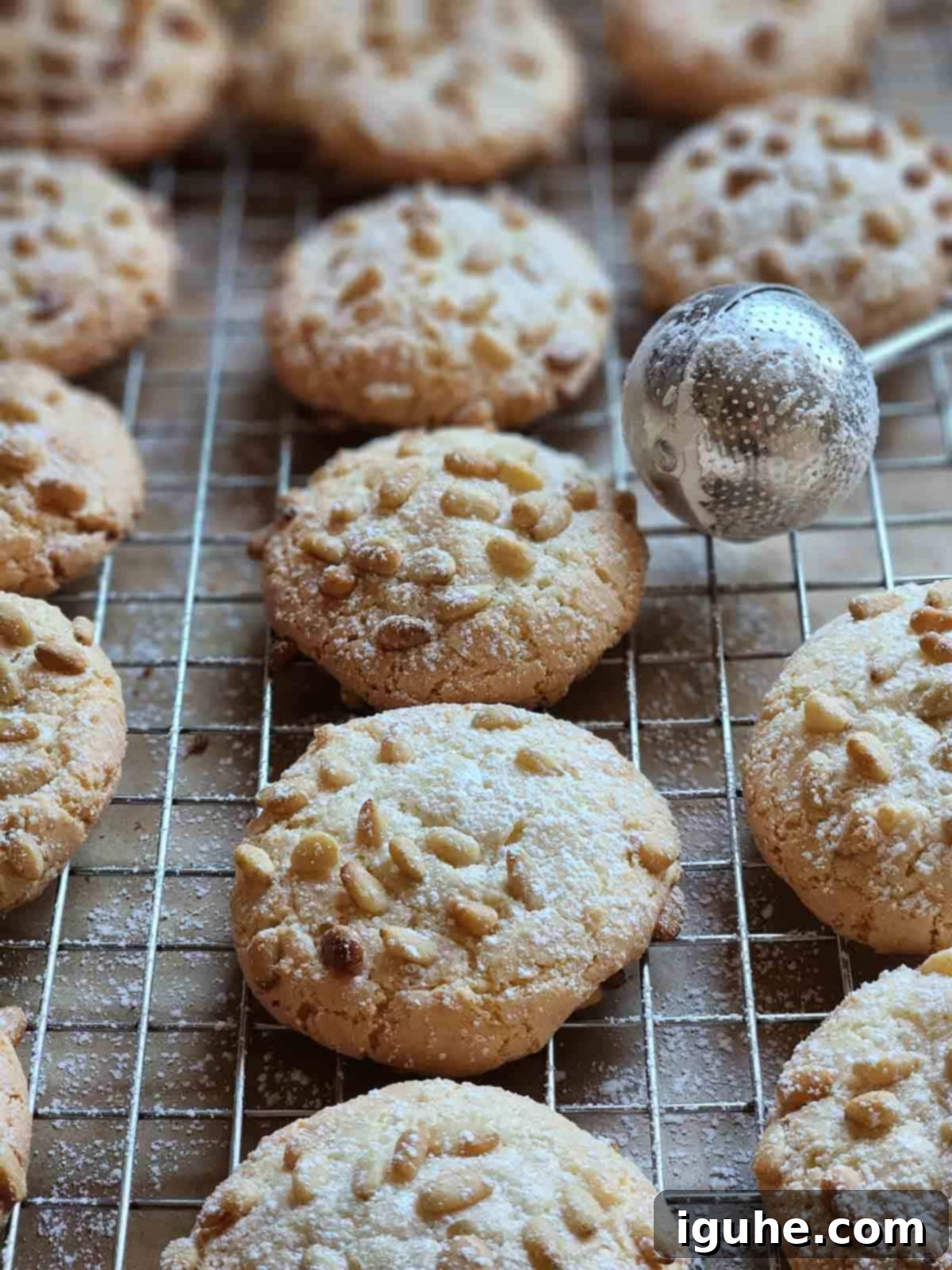
Storing and Freezing Your Pignoli Cookies
Once your exquisite pignoli cookies have completely cooled and been dusted with powdered sugar, they are ready for storage. To maintain their freshness, store them in an airtight container at room temperature. They will remain wonderfully soft and chewy for up to one week. For longer storage, pignoli cookies also freeze beautifully, allowing you to prepare them in advance for holidays or unexpected guests.
- Freezing Baked Cookies: Arrange fully cooled cookies in a single layer on a baking sheet and freeze until solid. Once frozen, transfer them to a freezer-safe airtight container or heavy-duty freezer bag, separating layers with parchment paper to prevent sticking. They can be frozen for up to 2-3 months. Thaw at room temperature for a few hours before serving.
- Freezing Unbaked Dough: While less common for this type of batter, you can freeze scooped portions of the dough (without pine nuts) on a parchment-lined tray until firm. Transfer to a freezer bag. When ready to bake, thaw the dough in the refrigerator overnight, then press pine nuts on top and bake as directed, possibly adding a minute or two to the baking time.
Frequently Asked Questions About Pignoli Cookies
Yes, a stand mixer is highly recommended to achieve the light, creamy, and airy batter that gives pignoli cookies their signature texture. The consistent and powerful beating action is difficult to replicate by hand. If you don’t have a stand mixer, a high-quality handheld electric mixer can also work effectively.
Yes, absolutely! One of the fantastic qualities of traditional pignoli cookies is that they are naturally gluten-free. They are made primarily with almond paste, sugar, egg whites, and pine nuts, none of which contain gluten, making them a wonderful treat for those with gluten sensitivities or dietary restrictions.
While both almond paste and marzipan are made from almonds, they are not interchangeable in this recipe. Almond paste is coarser, has a lower sugar content, and a more intense almond flavor. Marzipan is much sweeter, finer, and contains more sugar, which would significantly alter the texture and sweetness of the cookies, often leading to them spreading too much or becoming overly soft. For authentic pignoli cookies, always use true almond paste.
Pine nuts (pignoli) are indeed a key component, but their cost can be prohibitive. As an alternative, you can use thinly sliced almonds. While the flavor and texture will be slightly different (sliced almonds offer a milder taste and a flatter appearance), they still provide a pleasant nutty crunch that complements the almond base. If using sliced almonds, you might need a slightly larger quantity to cover the tops adequately.
The perfect pignoli cookie will have edges that are lightly golden brown and a bottom that is a more pronounced golden. The top, however, should remain mostly pale, with just a hint of color. They should feel set but still slightly soft to the touch in the center. Avoid heavy browning on top, as this indicates over-baking which can lead to a dry cookie. The characteristic crackly top is also a good indicator of doneness.
Variations and Serving Suggestions
While classic pignoli cookies are perfect as they are, there are a few ways to introduce subtle variations or enhance your serving experience:
- Add a hint of citrus: A touch of lemon or orange zest (about 1 teaspoon) added to the batter can brighten the almond flavor beautifully.
- Extra almond punch: For those who truly love almond flavor, a quarter teaspoon of pure almond extract can be added to the batter along with the egg whites.
- Chocolate drizzle: After the cookies have fully cooled, a delicate drizzle of melted dark or white chocolate can add an extra layer of indulgence and visual appeal.
- Perfect pairings: Serve your pignoli cookies with a rich cup of espresso, a robust coffee, or a gentle cup of tea. They also make an elegant addition to any dessert platter, especially during holidays or dinner parties.
Did you make this recipe? I would love to hear about it! Please leave a ⭐⭐⭐⭐⭐ rating with a comment right below the recipe card. If you snap a photo of your creation, don’t forget to tag me on Instagram @brunchandbatter.
📖 Recipe Card

Easy Italian Pignoli Cookies
Prevent your screen from going dark
Pin Recipe
10 minutes
17 minutes
27 minutes
Dessert
Italian
34 cookies (approximate depending on size)
137 kcal
Equipment
-
Stand mixer fitted with paddle attachment
-
2 or 3 baking/cookie sheets
-
Parchment paper or silicone baking mats
Ingredients
- 1 pound (16 ounces) almond paste not marzipan
- 1¾ cup (14 ounces) white granulated sugar
- 4 extra large egg whites slightly beaten
- 6 ounces pignoli (pine) nuts
- powdered sugar for dusting
Instructions
-
Preheat the oven to 350°F (175°C). Line 2 or 3 cookie sheets with parchment paper or silicone baking mats to prevent sticking.
-
Place the almond paste in the bowl of a stand mixer fitted with the paddle attachment. Beat on low/stir speed for a few minutes until it is smooth and pliable. This helps ensure an even texture. Avoid overbeating at this stage to prevent dryness.1 pound (16 ounces) almond paste
-
Add the granulated sugar and the slightly beaten extra-large egg whites to the bowl. Increase the mixer speed to medium and beat for about 5 minutes, or until the mixture becomes wonderfully smooth, creamy, and light in color.1¾ cup (14 ounces) white granulated sugar, 4 extra large egg whites
-
Allow the batter to rest for approximately 5-10 minutes. This resting period helps the batter to thicken slightly, making it easier to scoop and handle.
-
Using a cookie scoop (I recommend a #60 scoop for consistent sizing) or rounded tablespoons, drop portions of the batter onto the lined cookie sheets, ensuring they are about 1 inch apart. Gently press about 15-20 pine nuts onto the top of each cookie, making sure they adhere well.6 ounces pignoli (pine) nuts
-
Bake for 10 minutes. After the initial 10 minutes, rotate the pans 180 degrees to promote even baking. Continue to cook for an additional 7-9 minutes. The cookies should have golden brown bottoms and edges, but their tops should remain lightly colored and show a crackly surface. Do not overbake to maintain their soft, chewy interior.
-
Allow the cookies to cool completely on the pans. They will be delicate and sticky when warm. Once thoroughly cooled, use a thin, flexible spatula to carefully remove them. Finally, sprinkle generously with powdered sugar before serving.powdered sugar for dusting
Notes
-
- If you are buying the Odense brand of almond paste, please note they are sold in 7-ounce packages, not 8-ounce. For this reason, I prefer the Solo brand to ensure the correct amount of almond paste.
-
- The purity of your egg whites is crucial. If I get any yolk in the egg whites, I typically set that egg aside for another use. I always separate my eggs into a clear, separate dish before adding them to the main ingredients. This small step helps immensely in preventing any yolk from contaminating the whole batch (and is great if you accidentally get shell fragments!). I’ve experimented with large egg whites, but they often lead to inconsistent results, sometimes making the cookies taste flat or dense.
-
- Using a cookie scoop to drop the batter ensures uniform size, which is essential for even baking. I use a #60 cookie scoop, which holds approximately 1 tablespoon + ⅓ teaspoon of batter, or 0.54 ounces. If you don’t have a cookie scoop, aim for consistently sized heaping tablespoons of the cookie batter instead.
-
- Be sure to use parchment paper or a silicone baking mat to prevent sticking, as the bottoms of these cookies can become very sticky. I highly recommend using a thin, flexible spatula to easily transfer the cooled cookies to a wire rack without damaging them.
Storage: Cookies can be stored in an airtight container for up to 1 week at room temperature. For longer storage, see our section on freezing pignoli cookies above.
Nutrition*
Calories: 137kcal
Carbohydrates: 18.3g
Protein: 2.3g
Fat: 6.9g
Saturated Fat: 0.6g
Sodium: 6mg
Potassium: 77mg
Fiber: 0.8g
Sugar: 16.3g
Calcium: 25mg
*Nutrition information is provided as a courtesy and is an estimate only. Nutrition information can vary depending on many factors, such as products used, measurements and substitutions, therefore it is recommended that you obtain nutritional calculations based on your own finished recipe.
